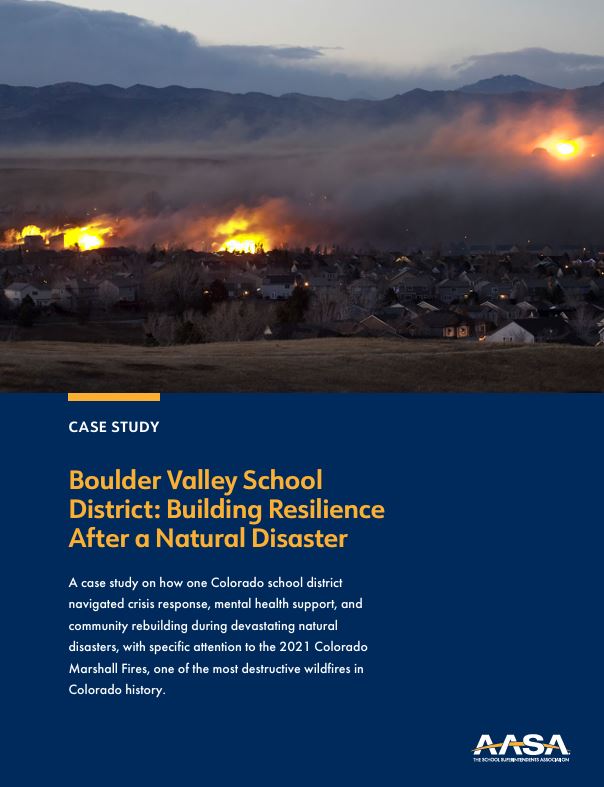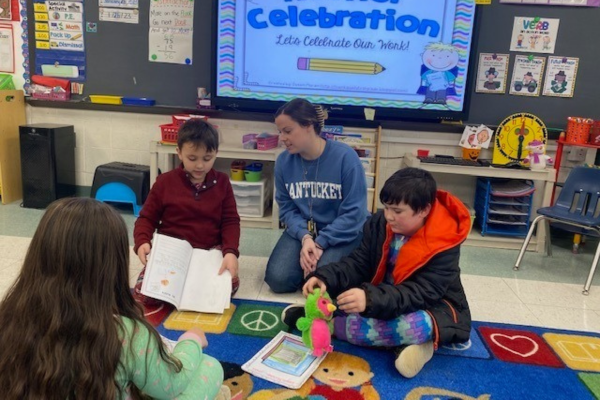Boulder Valley Strong: Responding to the Marshall Fires
March 28, 2025
Responding to the challenges of Colorado’s most destructive wildfire with resilience and a focus on well-being
Welcome to part two of a four-part blog series exploring how Boulder Valley School District in Colorado navigated natural disasters while building community resilience. The series will examine crisis response strategies, support systems, and leadership approaches during unprecedented challenges—providing valuable insights for districts preparing for or currently facing similar situations.

On December 30, 2021, Boulder Valley School District (BVSD) faced one of its most significant challenges in recent history—The Marshall Fires, one of Colorado’s most destructive wildfires. In a matter of hours, this blaze spread rapidly across Boulder County, burning over 6,000 acres, destroying nearly 1,000 structures, and forcing the evacuation of more than 37,500 people. Several BVSD schools were in the path of the fire, and many of our families and staff were directly affected. In the aftermath of this disaster, BVSD quickly mobilized to support the community. This post provides an overview of what happened and how our district responded.
Many of our families lost homes, personal belongings, and their sense of stability. Our schools, some located in directly affected areas, faced disruptions, as students and staff were impacted by the loss of property and disruption to their lives.
What Happened: A Brief Overview of the Marshall Fires
The Marshall Fires began around 11:00a.m, in two separate areas within Boulder County. Strong winds propelled the fires, causing them to spread swiftly, overwhelming fire departments and emergency services. The destruction was unprecedented, making it Colorado’s most devastating wildfire in history.
The impact on BVSD was profound. Many of our families lost homes, personal belongings, and their sense of stability. Our schools, some located in directly affected areas, faced disruptions, as students and staff were impacted by the loss of property and disruption to their lives.
The First Three Actions: Immediate Response to the Disaster
When disaster strikes, swift and organized action is essential. Here are the first three steps BVSD took in response to the Marshall Fires:
Communication and Immediate Safety Information: The first priority was to communicate with families. BVSD activated its communication systems, including our website and social media channels, to provide real-time updates about the situation.
Providing Immediate Mental Health Support: The trauma response team was mobilized to offer support to those directly impacted. We quickly set up counseling centers at our district office and 11 schools in the affected areas. These centers offered mental health services for students and families struggling with the emotional toll of the fire. Additionally, teams visited schools that were not directly affected to help students process their feelings of fear and anxiety.
Coordination with Community Partners: BVSD knew that community partnerships would be vital in managing the crisis. We immediately connected with Boulder County’s Office of Emergency Management, local shelters, and organizations like the American Red Cross. Together, we worked to ensure displaced families received information on housing, food, and other necessities. Our collective efforts helped provide immediate relief to those who had lost everything in the fire.
Together, we worked to ensure displaced families received information on housing, food, and other necessities. Our collective efforts helped provide immediate relief to those who had lost everything in the fire.
Showing Up for Our Families
In the immediate aftermath of the Marshall Fires, families were facing overwhelming uncertainty and loss. Many had lost their homes and personal belongings, and were desperately in need of stability and support. The following were the three most crucial needs that emerged during those first few days:
Clear, Consistent Communication: Families needed reliable information about where to go for support and when schools would reopen. BVSD provided regular updates via our communication channels and on-the-ground support teams, ensuring that families could stay informed in real time. Despite the overwhelming challenges, BVSD schools opened on time after the winter break, and we worked diligently to ensure that students and families had access to the resources they needed.
Mental Health and Emotional Support: In addition to logistical support, the emotional and psychological toll of the fires was significant. Our trauma response teams were mobilized to provide counseling services, not just to those directly affected, but to anyone experiencing grief, anxiety, and fear. We also coordinated with neighboring districts to ensure that mental health coverage was available for all BVSD buildings, helping to address the broader emotional impact on our community.
Practical Assistance: Many families were without essential items like food, clothing, and shelter. BVSD worked closely with community partners to provide information about where families could access immediate resources. Schools became hubs for practical assistance, offering backpacks (provided by Impact on Education), clothing, and household items donated by local organizations. Additionally, restaurants donated hot meals, and transportation was provided through the McKinney-Vento Homeless Assistance Act to ensure that students and families had access to support services.
Our trauma response teams were mobilized to provide counseling services, not just to those directly affected, but to anyone experiencing grief, anxiety, and fear.
Balancing Care for Staff While Supporting Our School Community
In addition to supporting students and families, BVSD had to consider the emotional well-being of its staff, many of whom were personally impacted by the fires. Finding a balance between showing up for staff and ensuring the continuity of education was challenging. Here are some strategies BVSD used to maintain that balance:
Recognize the Emotional Impact on Staff: It’s essential to acknowledge that staff are also grieving and impacted by disasters. BVSD provided counseling services and created spaces where staff could express their emotions and receive the support they needed. Staff members, many of whom had lost their homes or were dealing with trauma, were given the care they needed to continue their important work.
Foster a Flexible, Supportive Environment: BVSD offered flexible work arrangements for staff directly affected by the fires, allowing them time to manage personal affairs and care for their families. Providing this flexibility ensured that staff could recover emotionally without the added stress of rigid work demands.
Check in on Staff Well-being: After the fires, BVSD leadership regularly checked in with staff, not just to discuss their work but also to ensure they were receiving the emotional and mental health support they needed. Demonstrating care for staff helped to build resilience within our team.
Balance Compassion with Operational Needs: As much as empathy and compassion were needed, BVSD had to continue normal school operations. We worked with staff to create a clear plan for resuming normalcy while also acknowledging the emotional toll of the crisis. Providing structure and support helped staff feel more in control during an emotionally turbulent time.
Resources for Supporting Our Community
In the aftermath of the Marshall Fires, BVSD created several resources to support staff, students, and families through the recovery process:
Trauma Response Resources for Staff
Wildfire - Administrator Resource & Tips for Talking to Students
Tips When Talking to Students: Resource for Teachers/Parents
Tips for Talking to Our Students - An Educator's Guide
Video - Tips for Taking Care of Self and Talking Students
Prompts for Supporting Students
BVSD Marshall Fire Resource List
External resource: Center for Resilience & Wellbeing Marshall Fire Resource Page
Read part one of this blog series: "Boulder Valley Strong: Building Resilience and Support During Natural Disasters"






